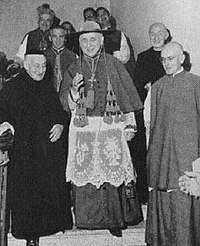Galero
This article includes a list of references, related reading, or external links, but its sources remain unclear because it lacks inline citations. (January 2010) |

A galero (pl. galeri; L. galerum, pl. galera) in the Catholic Church is a large, broad-brimmed tasseled hat worn by clergy. Over the centuries the galero was eventually limited in use to individual cardinals as a crown symbolizing the title of Prince of the Church. The red galero was first granted to cardinals by Pope Innocent IV in 1245 at the First Council of Lyon. Tradition in the Archdiocese of Lyon is that the red color was inspired by the red hats of the canons of Lyon. According to Noonan, Pope Innocent wanted his favorites to be distinct and recognizable in the lengthy processions at the council.
The cardinal Jean Cholet used his galero to crown Charles of Valois in 1285 at Girona during the Aragonese Crusade, pronouncing him King of Aragon, and resulting in roi du chapeau ("king of the hat") becoming Charles's nickname.
Second Vatican Council

When creating a cardinal, the Pope used to place a scarlet galero on the new cardinal's head in consistory, the practice giving rise to the phrase "receiving the red hat." In 1965, a papal decree during the Second Vatican Council ended the use of the galero. It was deemed that by removing such elaborate regalia, the people could better identify with their pastoral leaders. Today, only the scarlet zucchetto and biretta are placed over the heads of cardinals in consistory. A few cardinals from eastern rites wear distinctive oriental headgear. However, some cardinals continue to obtain galeri privately so that the old ceremony of its suspension over their tombs may be observed.
When a cardinal dies, it is traditional that his galero be suspended over his tomb, where it remains until it is reduced to dust, symbolizing how all earthly glory is passing. In the United States, where only a few cathedrals have crypts, the galeri of past archbishops who were cardinals are suspended from the ceiling. Some of the Cathedral churches in the United States of America that hang the galeri of past Cardinals from their ceilings are:
- Basilica of the Assumption, co-cathedral of Baltimore, Maryland
- Cathedral Basilica of Saint Louis, St. Louis, Missouri
- Cathedral of Mary Our Queen, Baltimore, Maryland
- Cathedral of Our Lady of the Angels, Los Angeles, California
- Cathedral of St. Matthew the Apostle, Washington, D.C.
- Holy Cross Cathedral, Boston, Massachusetts
- Holy Name Cathedral, Chicago, Illinois
- St. Patrick's Cathedral, New York City
- Cathedral of the Most Blessed Sacrament, Detroit, Michigan
Even though the custom had been abolished, relatives of the late Cardinal Basil Hume, Archbishop of Westminster (UK) had a galero made and installed above his tomb in St George's Chapel of Westminster Cathedral, as other previous cardinals had, after he died in 1999.
On February 19, 2011, Raymond Cardinal Burke became the first cardinal in recent times to wear the galero[1]
Ecclesiastical heraldry

The galero (or "ecclesiastical hat") is still in use today in ecclesiastical heraldry as part of the achievement of the coat of arms of an armigerous Catholic cleric. The ecclesiastical hat replaces the helmet and crest, because those were considered too belligerent for men in the clerical state. The color of the hat and number of tassels indicate the cleric's place in the hierarchy. Generally, priests and ministers have a black hat with cords and tassels, the number depending upon their rank. Bishops generally use a green hat with green cords and six green tassels on each side, archbishops have likewise a green hat with green cords and ten green tassels on each side, and cardinals have a red hat with red cords and fifteen red tassels on each side. Depiction in arms can vary greatly depending on the artist's style.
Ecclesiastical hats are used also by ministers of other Christian communities. Alongside Catholic clergy, the Scots Public Register records its use by Episcopalian and Presbyterian ministers. The Moderator of the General Assembly of the Church of Scotland uses a black hat, with blue cords and ten tassels.
References
- Fox-Davies, A.C. (1913). . In Herbermann, Charles (ed.). Catholic Encyclopedia. New York: Robert Appleton Company.
- Goyau, Georges (1913). . In Herbermann, Charles (ed.). Catholic Encyclopedia. New York: Robert Appleton Company.
- Goyau, Georges (1913). . In Herbermann, Charles (ed.). Catholic Encyclopedia. New York: Robert Appleton Company.
- "Instruction on the dress, titles and coat-of-arms of cardinals, bishops and lesser prelates." L'Osservatore Romano, English ed. 17 Apr 1969: 4. ISSN 0391-688X. Online at http://www.fiu.edu/~mirandas/instruction69.htm
- Noonan, Jr., James-Charles (1996). The Church Visible: The Ceremonial Life and Protocol of the Roman Catholic Church. Viking. p. 191. ISBN 0-670-86745-4.
- Philippi, Dieter (2009). Sammlung Philippi - Kopfbedeckungen in Glaube, Religion und Spiritualität,. St. Benno Verlag, Leipzig. ISBN 978-3-7462-2800-6.
